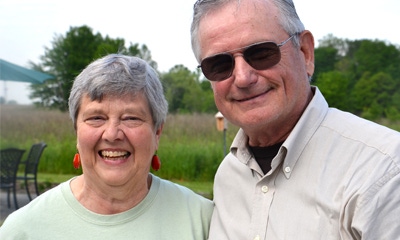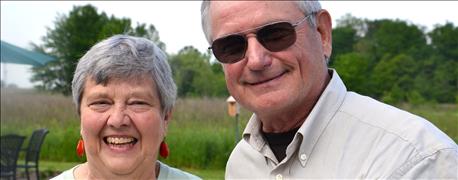
Just south of Versailles and across the road from the Ripley County Soil and Water Conservation District office lies a farm that once produced cattle, corn, soybeans and other crops. Today it’s a haven for wildlife and birds, and a model of what can be accomplished if your goal is strictly protecting the soil and letting Mother Nature do her thing. It’s one reason why Bob and Ellen Mulford’s Capability Acres was selected to host a 30th anniversary celebration for the Conservation Reserve Program recently. There were dignitaries and people from multiple agencies present, but Bob Mulford stole the show from the very beginning.

ALL ABOUT CONSERVATION: Every acre on Bob and Ellen Mulford's 400-acre farm has a purpose: promoting conservation of wildlife and protecting the soil at the same time.
“We just love to be out here and see all the birds and wildlife,” he beamed. “We’ve even got a snake that lives in a tree in the front yard near the driveway. It’s awesome.”
To each his own, but he wasn’t kidding about the snake. It made an appearance in time to greet those leaving the farm after the tour.
Early years
Mulford’s grandfather bought the original 160 acres for the farm after the government purchased his farm in 1940 while putting together Jefferson Proving Grounds, a huge military testing area in Ripley and Jefferson counties that played a key role in developing weaponry for World War II.
Mulford, a physician, and his wife, Ellen, returned to live on the farm in 1974 after Bob completed medical school. They wanted to raise their family there. Bob had a local general practice, and Ellen taught first grade at a nearby elementary school. One reason they returned there was to teach their children about nature.
“Grandfather fostered my love of nature early in life,” Mulford said. “My first fish was caught on the farm, along with a particularly uncomfortable case of chiggers.
“My first squirrel was killed with my grandfather’s Fox shotgun. I marveled at every animal, insect, bird or any other living thing I observed on the farm. The die was cast. Whatever direction my life would take would have to include this farm.”
The cattle left the farm in the late 1970s. A neighboring farmer grew crops on about half the farm for many years. One incident that happened during that time made a lasting impression on Mulford. He recorded it in comments he prepared especially for the CRP 30th anniversary celebration.
“One year there was an accidental herbicide spill involving a small area, about 100 square feet. Nothing grew, not even one blade of grass, in over five years. I called this area Chernobyl.
“Its bare countenance gave me daily pause to think about the abuse of the land occurring on the farm. Rachel Carson’s ‘Silent Spring' was being re-enacted here.”
By 2010, the Mulfords decided it was time for a change. They were in a position to convert the entire farm to grass and trees, and foster the return of birds and wildlife. Mulford visited Tim Schwipps, the Ripley County district conservationist for the Natural Resources Conservation Service, and began making plans to convert the farm into what it is today.
“We get excited about this,” he said. “Birder groups come here from all over, and we’ve hosted many other groups. We’ve got some plants and wildlife here that you don’t find on your average farm. We’re thrilled with what we’ve been able to do.”
About the Author(s)
You May Also Like




